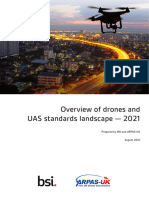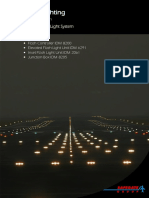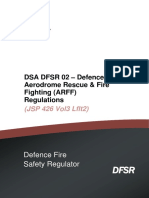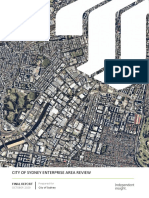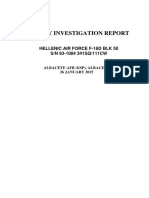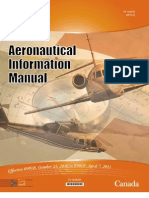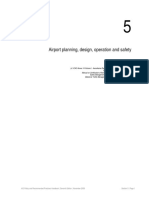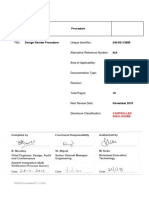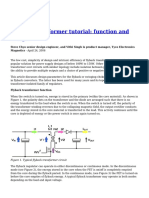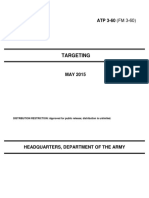Npa 09-2013 - Caap 71 Helidecks (Off-Shore)
Npa 09-2013 - Caap 71 Helidecks (Off-Shore)
Uploaded by
Legend AnbuCopyright:
Available Formats
Npa 09-2013 - Caap 71 Helidecks (Off-Shore)
Npa 09-2013 - Caap 71 Helidecks (Off-Shore)
Uploaded by
Legend AnbuOriginal Description:
Original Title
Copyright
Available Formats
Share this document
Did you find this document useful?
Is this content inappropriate?
Copyright:
Available Formats
Npa 09-2013 - Caap 71 Helidecks (Off-Shore)
Npa 09-2013 - Caap 71 Helidecks (Off-Shore)
Uploaded by
Legend AnbuCopyright:
Available Formats
NPA No.
09/2013
CIVIL AVIATION ADVISORY PUBLICATION (CAAP) 71
HELIDECKS (OFF-SHORE)
Release Date: 18
July 2013
The General Civil Aviation Authority (GCAA) has concluded a review into the regulatory and safety
oversight of aerodromes
1
within the UAE. This review has included aerodromes and heliports /
helidecks.
As a consequence, an evaluation has been undertaken of the requirement for helidecks with reference
to ICAO Annex 14 Volume II (Heliports) and the approach to provide safety oversight for off-shore
helidecks in the UAE.
This NPA is introducing a new CAAP as detailed in Section B to this NPA and is also introducing changes
to Civil Aviation Regulations as detailed in Section A to this NPA.
The aim of this CAAP is to provide guidance to operators of helidecks; it also aims to introduce a
process for safety oversight.
The proposed CAAP should ensure compliance with the UAE Civil Aviation Law; Civil Aviation
Regulations (referenced below) and conformance with the international standards of ICAO Annex 14,
Volume I (Aerodromes) and Volume II (Heliports).
CAR PART IV, OPS 3.220 (Commercial and Private Air Transportation:
Helicopters):Authorisation of Heliports by the Operator: An operator shall only authorise use of
heliports that are adequate for the type(s) of helicopter and operation(s) concerned.
The implementation of the GCAA regulatory and safety oversight process will however, commence at a
later date, (a date will be provided by a GCAA publication, following the publication of the CAAP and
the amended Civil Aviation Regulations).
CAAP 71 will be subject to change as a result of ICAO Amendment Number 5 to ICAO Annex 14 Volume
II which, subject to adoption by the ICAO Council, will become applicable on 14
th
November 2013. The
ICAO Effective Date is 15
th
July 2013, following which information can be obtained on request; email:
ana@gcaa.gov.ae.
The CAAP and the amendment to the Civil Aviation Regulations will be issued once the NPA and
consultation process has been completed.
This Notice of Proposed Amendment is published for the aviation industry, all concerned parties and
appropriate local authorities in each Emirate, in order to:
1. Review the attached proposed publication;
2. Submit their comments online through the GCAA website by 31
st
October 2013 from the date
of this NPA.
1
A defined area on land or water (including any buildings, installations and equipment) intended to be used either wholly or in
part for the arrival, departure and surface movement of aircraft.
CAAP 71 Page 2 of 32
July 2013
Comments must be submitted through the GCAA Website E-Publication Notice of Proposed
Amendment, using the Action of Submit NPA Feedback Request.
CAAP 71 Page 3 of 32
July 2013
Section A to NPA 09-2013
1. PROPOSED AMENDMENT TO CAR PART IX (AERODROMES)
1.1 Applicability (Chapter 1 paragraph 1.2.1): These Regulations apply to all aerodromes served by
aircraft conducting an Air Service within the UAE, and other aerodromes which provide operations
using instrument approach or departure procedures.
1.2 Definition (Chapter 1 paragraph 1.3.3):
a) Deletion of: Aerodrome Certificate Low Capacity
b) Addition of: Aircraft or Helicopter Landing Area Acceptance - landing areas which are not
for Air Service operations and do not have instrument runways. (Excluding areas used
solely for Light Sport Aircraft).
1.3 Requirements to hold an Aerodrome or Heliport Certificate or an Aircraft or Helicopter Landing
Area Acceptance (Chapter 2 paragraph 2.1.1): An operator of an aerodrome served by aircraft
conducting an Air Service and other aerodromes which provide operations using instrument
approach or departure procedures shall be in possession of an Aerodrome or Heliport Certificate.
An operator of a landing area which is not providing an Air Service and which does not have
instrument runways, shall hold an Aircraft or Helicopter Landing Area Acceptance, (excluding areas
used solely by Light Sport Aircraft).
(It is proposed that reference will be made to CAAP 71, which will become regulation under CAR
Part IX).
1.4 Appendix 16 - Heliports
2
: This currently directs readers to ICAO Annex 14 Volume II. When the
process for GCAA regulatory oversight at heliports is implemented, the content of CAAP 71 will be
transferred to CAR Part IX and referred to as GCAA Regulation.
2. AERODROME (HELIPORT) CERTIFICATE OR AIRCRAFT (HELICOPTER) LANDING AREA ACCEPTANCE
2.1 Aerodrome operators are advised to assess their operations against Table 1, which provides
additional clarity regarding the conduct of an Air Service.
a) Aerodrome or Heliport Certification:
This applies to aerodromes which are open to public use and which serve Commercial Air
Transport offering an Air Service and other aerodromes which provide operations using
instrument approach or departure procedures.
Reference shall be made to CAR Part IX and CAAP 30 (The Issue & Renewal of an
Aerodrome Certificate), which refers to the process to be followed to gain an Aerodrome
or Heliport Certificate.
b) Aircraft or Helicopter Landing Area Acceptance:
This applies to landing areas which are not for Air Service operations and do not have
instrument runways, (excluding areas used solely for Light Sport Aircraft).
2
Heliport mean an aerodrome or a defined area on a structure intended to be used wholly or in part for the arrival, departure
and surface movement of helicopters.
CAAP 71 Page 4 of 32
July 2013
3. GCAA REGULATORY OVERSIGHT: HELIPORTS
3.1 Physical characteristics (dimensions) and visual aids will require approval or acceptance from the
Air Navigation and Aerodrome Department, with reference to CAR Part IX and CAAP 70.
3.2 Operational aspects in terms of: flight direction, operating procedures and obstacle limitation
surfaces, dependent upon the largest set of dimensions and performance criteria that a heliport is
intended to serve, will receive oversight from Flight Operations Department with reference to CAR
Part IV-OPS 3.
4. IMPLEMENTATION OF REGULATION
4.1 The date for the proposed amendment to CAR Part IX and for the implementation of the GCAA
regulatory and safety oversight process will be notified by a GCAA publication.
4.2 It is intended that implementation will be in the form of a phased approach, with new construction
and operations conforming to regulation from the implementation date.
4.3 Actions to achieve compliance with regulation at existing locations will be phased over a period of
time in agreement with the GCAA.
4.4 It will be a requirement to hold a certificate or landing area acceptance in order to operate or to
continue operations.
5. SERVICE FEES
5.1 Aerodrome or Heliport Certificate holders and holders of Aircraft or Helicopter Landing Area
Acceptance will be subject to initial and ongoing annual fees.
CAAP 71 Page 5 of 32
July 2013
TABLE 1: REQUIREMENTS FOR AERODROME / HELIPORT CERTIFICATION OR AIRCRAFT / HELICOPTER
LANDING AREA ACCEPTANCE REGARDING THE CONDUCT OF AN AIR SERVICE
This Table should be used to evaluate if operations require an aerodrome to be certificated under the
definition of Air Service (UAE Civil Aviation Law) with operations as referred to in paragraph 5, or to
following the Aircraft Landing Area Acceptance process as described in CAAP 70 and CAAP 72.
NOTE 1: The categorisation of flights for Public Transport may differ for Flight Crew Licensing, Flight
Operations and Airworthiness. Applicable Regulation should therefore apply. The issue of an
Aerodrome / Heliport Certificate or Aircraft /Helicopter Landing Area Acceptance, does not constitute
an approval from Flight Operations Department.
NOTE 2: For landing areas categorised as Acceptance and not part of the audit/inspection
programme, the GCAA assumes no responsibility for the condition of the landing area, presence of
obstacles or operations at the location.
Type of Operation Status
Aerodrome
Certification or
Aircraft Landing
Area
Acceptance
1
Payment is made for the carriage of passengers, mail or cargo
(other than crew).
Air Service
Aerodrome /
Heliport
Certificate
2
Passengers, mail and cargo are carried for no payment, by an
AOC holder.
Air Service
Aerodrome /
Heliport
Certificate
Phased Process for Aircraft Landing Area Acceptance (proposed 2014) Initial Self-Assessment
3
Payment is only for the pilot; for example, this allows a private
owner to pay a flying instructor for a flying lesson in the owners
aircraft.
Private
Operator
Aircraft Landing
Area
Acceptance
4
Flying Displays and Races
Direct costs (i.e. fuel) for no profit is permitted, but excludes
payment to the pilot.
Private
Operator
Aircraft Landing
Area
Acceptance
5
Cost Sharing
Provided that the only payment is a contribution to the direct
costs of the flight otherwise payable by the pilot in command.
Private
Operator
Aircraft Landing
Area
Acceptance
6
Parachuting
Note: Approval required in accordance with GCAA CAR Part IV
Special Purpose Operations: Section C, Parachuting Operations.
CAR Part IV
OPS 3,
Sections C
Aircraft Landing
Area
Acceptance
7
Flying Schools
Note: Approval required in accordance with GCAA CAR Part IV
Special Purpose Operations: Section A, Approved Flying Schools.
CAR Part IV
OPS 3,
Sections A
Aircraft Landing
Area
Acceptance
8
Hospitals / Clinics
Operations to facilities will be required to apply special
procedures.
Public
Service
Heliport Landing
Area
Acceptance
CAAP 71 Page 6 of 32
July 2013
Other Operations
9
Police / SAR
Certification or acceptance will not apply to landing areas used
solely for the purpose of operating police or SAR aircraft.
- Not required
10
Off-Shore Helideck Operations
Dedicated operations to off-shore helideck sites.
-
Acceptance - Oil
and Gas
Companies
11
Off-Shore Helideck Operations
Multi-platform configuration. (Facilities consisting of more than
one helideck, serving accommodation)
Air Service
Helideck
Certificate
CAAP 71 Page 7 of 32
July 2013
Section B to NPA 09-2013
CIVIL AVIATION ADVISORY PUBLICATION
CAAP 71
HELIDECKS (OFF-SHORE)
STANDARDS, GUIDANCE AND INFORMATION REGARDING HELIDECKS
CHAPTER 1 INTRODUCTION
1 GENERAL
In this publication the term helideck refers to all helicopter landing areas on fixed or floating off-
shore facilities used for the exploration of oil and gas. For helicopter landing areas on vessels the
term 'shipboard heliport' may be used in preference to helideck.
2 PURPOSE
The purpose of this CAAP is to provide guidance and policy information to all helideck operators of UAE
off-shore installations.
3 IMPLEMENTATION OF SAFETY OVERSIGHT
3.1 CAR Part IX (Aerodromes), Appendix 16 - Heliports: This Appendix currently directs readers to
ICAO Annex 14 Volume II (Heliports). It is proposed that this Appendix will be amended to refer to CAAP
71.
3.2 It is intended that implementation will be a phased approach, with new construction and
operations conforming to regulation from the implementation date.
3.3 Compliance with regulation at established facilities will be phased over a set period in agreement
with the GCAA.
3.4 It will be a requirement to hold a certificate or a landing area acceptance in order to operate or
to continue operations.
4 STATUS OF THIS CAAP
This is the first issue of CAAP 71. It will remain current unless withdrawn or superseded.
5 APPLICABILITY
This CAAP is applicable to all operators or prospective operators of helidecks in the UAE.
6 REFERENCES
CAAP 71 Page 8 of 32
July 2013
a) CAR Part IV: Operational Regulations OPS 3: Commercial & Private Air Transportation
(Helicopter)
b) CAR Part IX (Aerodromes)
c) CAR Part X (Safety Management Requirements)
d) CAR Part XI (Aerodrome Emergency Services, Facilities and Equipment)
e) ICAO Annex 14 Volume II (Aerodromes Heliports)
f) ICAO Heliport Manual Doc 9261-AN/903
g) ICAO Airport Service Manual Part 1 Rescue & Fire-Fighting
h) National Fire Protection Association (NFPA) 418 Standards for Heliports
i) CAAP 22 (Safety Incident Reporting)
j) CAAP 35 (Inspecting and Testing of Rescue and Fire-Fighting Equipment)
k) CAAP 36 (Runway and Movement Area Inspections)
l) CAAP 43 (Foreign Object Debris FOD)
m) CAAP 50 (Safety Management Systems)
n) CAAP 57 (Voluntary Occurrence Reporting System)
o) CAAP 70 Heliports: Air Service and Private Use (Not Air Service)
p) ICAO Annex 15 (Aeronautical Information Services)
q) UK CAP 437 (Offshore Helicopter Landing Areas Guidance on Standards).
7 GUIDANCE
For guidance on points that are not covered within this publication, advice should be sought from the
Aviation Safety Affairs Sector, GCAA; email: ana@gcaa.gov.ae.
8 POLICY
8.1 The criteria described in this CAAP, CAAP 70 and CAR Part IV OPS 3 form part of the
requirements and guidance material issued by the GCAA to helideck and helicopter operators, which
is to be accounted for in Operations Manuals required under CAR Part IV OPS 3.
8.2 For information which relates to both on-shore as well as off-shore facilities, then in addition,
reference shall be made to CAAP 70.
8.3 For additional information specific to helidecks and shipboard heliports, reference is made within
this CAAP to ICAO Heliport Manual Doc 9261.
8.4 It is recommended that helicopter operators refer to UK CAP 437 (Off-shore Helicopter Landing
Areas Guidance on Standards). UK CAP 437 is an amplification of internationally agreed standards
contained in ICAO Annex 14 Volume II, Heliports and the ICAO Heliport Manual Doc 9261-AN/903.
8.5 CAR Part IV OPS 3 (Operational Regulations: Helicopters) provides regulation specifically for
helicopter operations. Helideck operators should make reference to this document as an appreciation
of the helicopter operators responsibilities as holder of an air operator certificate (AOC). Such
operators shall ensure that all pilots are familiar with the regulations and procedures pertinent to the
performance of their duties.
CAAP 71 Page 9 of 32
July 2013
9 CONTENTS
Chapter 1 Introduction ................................................................................................................................ 7
1 General........................................................................................................................................... 7
2 Purpose .......................................................................................................................................... 7
3 Implementation of Safety Oversight ............................................................................................ 7
4 Status of this CAAP ........................................................................................................................ 7
5 Applicability ................................................................................................................................... 7
6 References ..................................................................................................................................... 7
7 Guidance ........................................................................................................................................ 8
8 Policy .............................................................................................................................................. 8
9 Contents ......................................................................................................................................... 9
10 Definitions .................................................................................................................................... 11
11 Abbreviations ............................................................................................................................... 13
Chapter 2 Process For GCAA Acceptance & CERTIFICATION ................................................................... 14
1 Acceptance and Certification ...................................................................................................... 14
Chapter 3 Physical Characteristics: Helidecks .......................................................................................... 15
1. Final Approach and Take-Off Areas and Touchdown and Lift-Off Areas ................................... 15
Chapter 4 Physical Characteristics: Shipboard ......................................................................................... 16
1 Final Approach and Take-Off Areas & Touchdown and Lift-Off Areas ...................................... 16
Chapter 5 Physical Characteristics: Safety Net & Structural Design ........................................................ 18
1. Safety Net .................................................................................................................................... 18
2. Structural Design Strength .......................................................................................................... 18
Chapter 6 Obstacle Restriction and Removal ........................................................................................... 19
1 Obstacle-Free Sector / Surface - Helidecks ................................................................................ 19
2 Limited Obstacle Surface - Helidecks .......................................................................................... 19
3 Obstacle Limitation Requirements ............................................................................................. 21
Chapter 7 Visual Aids: Markings and Markers .......................................................................................... 26
1 Winching Area Marking ............................................................................................................... 26
2 Helideck Identification Marking .................................................................................................. 26
3 Maximum Allowable Mass Marking ........................................................................................... 26
4 Maximum allowable D-Value Marking ....................................................................................... 26
5 Touchdown / Positioning Marking .............................................................................................. 26
6 Heliport Name Marking ............................................................................................................... 27
7 Helideck Obstacle-Free Sector Marking ..................................................................................... 27
8 Helideck Surface Marking ........................................................................................................... 27
9 Helideck Prohibited Landing Sector Marking ............................................................................. 28
Chapter 8 Aeronautical Lights ................................................................................................................... 29
CAAP 71 Page 10 of 32
July 2013
1 Touchdown and Lift-Off Area Lighting System ........................................................................... 29
2 Winching Area Floodlighting ....................................................................................................... 29
Chapter 9 Rescue and Fire Fighting Facilities ........................................................................................... 31
Appendix A: GCAA CAAP 71 Application Form ............................................................................................ 32
CAAP 71 Page 11 of 32
July 2013
10 DEFINITIONS
Aerodrome A defined area on land or water (including any buildings, installations,
and equipment) intended to be used either wholly or in part for the
arrival, departure and surface movement of aircraft.
Aircraft Any machine that can derive support in the atmosphere from the
reactions of the air other than the reactions of the air against the
earths surface.
Air Service An air service operation open to the public and performed by an
aircraft for the public transport of passengers, mail or cargo for
remuneration or hire.
Approved by the
Authority
Documented by the Authority as suitable for the purpose intended.
Authority The General Civil Aviation Authority of the United Arab Emirates is
the competent body responsible for the safety regulation of Civil
Aviation.
Commercial Air Transport
Operation
An aircraft operation involving the transport of passengers, cargo or
mail for remuneration or hire.
Declared Distances a) Take-off distance available (TODAH). The length of the FATO
plus the length of helicopter clearway (if provided) declared
available and suitable for helicopters to complete the take-
off.
b) Rejected take-off distance available (RTODAH). The length of
the FATO declared available and suitable for helicopters
operated in performance class 1 to complete a rejected take-
off.
c) Landing distance available (LDAH). The length of the FATO
plus any additional area declared available and suitable for
helicopters to complete the landing manoeuvre from a
defined height.
Dynamic load-bearing
surface
A surface capable of supporting the loads generated by a helicopter
conducting an emergency touchdown on it.
Elevated heliport A heliport located on a raised structure on land.
Final approach and take-
off area (FATO)
A defined area over which the final phase of the approach
manoeuvre to hover or landing is completed and from which the
take-off manoeuvre is commenced. Where the FATO is to be used by
helicopters operated in performance class 1, the defined area
includes the rejected take-off area available.
GCAA Inspector An Inspector from any discipline within ANA, dependent upon
discipline being inspected or audited.
CAAP 71 Page 12 of 32
July 2013
Helicopter Landing Area
(Helideck) Project Plan
A comprehensive plan detailing as a minimum:
a) timescales and milestones with reference to meeting
regulatory requirements and the guidance provided in CAAP
70 and 71;
b) a compliance matrix, demonstrating compliance with GCAA
regulations, detailing physical characteristics, appropriate to
the scope and scale of the proposed operations.
Helicopter stand An aircraft stand which provides for parking a helicopter and where
ground taxi operations are completed or where the helicopter
touches down and lifts off for air taxi operations.
Helideck A heliport located on an offshore structure such as an exploration or
production platform used for the exploitation of oil or gas.
Helideck Facilities and
Equipment
Facilities and equipment, inside or outside the boundaries of the
helideck, that are constructed or installed, operated and maintained
for the arrival, departure and surface movement of aircraft.
Helideck Manual The Manual that forms part of the application for registration.
Helideck Operator In relation to a registered helideck.
Heliport An aerodrome or a defined area on a structure intended to be used
wholly or in part for the arrival, departure or surface movement of
helicopters.
Manoeuvring area That part of an aerodrome to be used for the take-off, landing and
taxiing of aircraft, excluding aprons.
Movement area That part of an aerodrome to be used for the take-off, landing and
taxiing of aircraft, consisting of the manoeuvring area and the
apron(s).
Operator (Flight
Operator)
A person, organization or enterprise engaged in or offering to
engage in an aircraft operation.
Private operator Private operator means a person, organization or enterprise engaged
in the carriage of persons or cargo not for hire or reward.
Protection area An area within a taxi-route and around a helicopter stand which
provides separation from objects, the FATO, other taxi-routes and
helicopter stands, for safe manoeuvring of helicopters
Rejected take-off area A defined area on a heliport suitable for helicopters operating in
performance class 1 to complete a rejected take-off.
Safety area A defined area on a heliport surrounding the FATO which is free of
obstacles, other than those required for air navigation purposes, and
intended to reduce the risk of damage to helicopters accidentally
diverging from the FATO.
Shipboard heliport
A heliport located on a ship that may be purpose or non- purpose-
built. A purpose-built shipboard heliport is one designed specifically
for helicopter operations. A non-purpose-built shipboard heliport is
one that utilizes an area of the ship that is capable of supporting a
helicopter but not designed specifically for that task.
CAAP 71 Page 13 of 32
July 2013
Static load-bearing
surface
A surface capable of supporting the mass of a helicopter situated
upon it.
Surface-level heliport A heliport located on the ground or on the water.
Touchdown and lift-off
area (TLOF)
An area on which a helicopter may touch down or lift off.
Winching area An area provided for the transfer by helicopter of personnel or
stores to or from a ship.
11 ABBREVIATIONS
AIP Aeronautical Information Publication
(A)PAPI Abbreviated Precision Approach Path Indicator
ASPSL Arrays of Segmented Point Source Lighting
D Helicopter greatest overall dimension
FATO Final Approach and Take-Off Area
FOD Foreign Object Debris
HAPI Helicopter Approach Path Indicator
HFM Helicopter Flight Manual
ICAO International Civil Aviation Organisation
IMC Instrument Meteorological Conditions
LED Light Emitting Diodes
LP Luminescent Panel
MTOM Maximum Take-Off Mass
RD Diameter of the largest rotor
SMS Safety Management System
TLOF Touchdown and Lift-Off Area
UCW Width of undercarriage
VMC Visual Meteorological Conditions
CAAP 71 Page 14 of 32
July 2013
CHAPTER 2 PROCESS FOR GCAA ACCEPTANCE & CERTIFICATION
1 ACCEPTANCE AND CERTIFICATION
1.1 GCAA acceptance is applicable for helicopter landing areas on fixed or floating off-shore
facilities used for the exploration of oil and gas.
1.2 GCAA acceptance is also applicable for on-shore sites which are dedicated to the exploration of
oil and gas.
1.3 Certification is required for those facilities which are designated as multi-platform
configurations. Certification shall adhere to compliance with GCAA regulation.
1.4 Service Fees applicable to the scale of operations for either GCAA acceptance or certification will
be required.
1.5 The GCAA may choose to review those facilities listed as acceptance; certification will follow
a more detailed assessment which may involve site inspections and this will be undertaken by the
following departments:
a) Air Navigation and Aerodrome Department: will assess the physical characteristics and
visual aids
b) Flight Operations Department: will assess the application of the operations for which the
facility is designed, in relation to CAR Part IV OPS 3. This will include the direction of flight;
the assessment of the obstacle environment on the basis of the intended use of a FATO; the
acceptance of the Declared Distances and obstacle limitation surfaces in relation to the most
critical helicopter type for which the helideck is intended.
c) Aviation Security Affairs Sector: Aviation security is an integral part of aerodrome planning
and operations. Contact should be made with GCAA Aviation Security Affairs Sector for details
regarding security requirements
3
.
1.6 It will be the responsibility of each oil/gas producer to maintain their registry or list of active
facilities.
1.7 Each oil/gas organisation should submit details to the GCAA. This should include details of their
safety oversight programme and their actions or programme to address non-compliant elements.
Details may take the form of a safety case or an Aircraft Landing Area (Helideck) Project Plan and
should reflect the regulations in CAR Part IV-OPS 3, CAAP 70, CAAP 71 and UK CAP 437.
1.8 The GCAA CAAP 71 Application Form (Appendix A) should be submitted to:
a) Post: Attn: Director, ANA
Off-Shore Helideck Application
GCAA, Aerodrome Section
PO Box 6558, Abu Dhabi, UAE
b) Email: ana@gcaa.gov.ae
3
GCAA CAR Part VII Aviation Security Regulations
CAAP 71 Page 15 of 32
July 2013
CHAPTER 3 PHYSICAL CHARACTERISTICS: HELIDECKS
Note In addition to the specification listed within this Chapter, reference shall also be made to
CAAP 70.
Note The following specifications are for helidecks located on structures engaged in such activities
as mineral exploitation, research or construction. See Chapter 4 for shipboard heliport provisions.
1. FINAL APPROACH AND TAKE-OFF AREAS AND TOUCHDOWN AND LIFT-OFF AREAS
Note On helidecks it is presumed that the FATO and the TLOF will be coincidental. Reference to
FATO within the helideck section of this CAAP is assumed to include the TLOF. Guidance on the effects
of airflow direction and turbulence, prevailing wind velocity and high temperatures from gas turbine
exhausts or flare radiated heat on the location of the FATO is given in the Heliport Manual (Doc
9261).
1.1 A helideck shall be provided with at least one FATO.
1.2 A FATO may be any shape but shall be of sufficient size to contain:
a) for helicopters with an MTOM of more than 3,175 kg, an area within which can be
accommodated a circle of diameter not less than 1.0 D of the largest helicopter the helideck
is intended to serve; and
b) for helicopters with an MTOM of 3,175 kg or less, an area within which can be accommodated
a circle of diameter not less than 0.83 D of the largest helicopter the helideck is intended to
serve.
1.3 Recommendation For helicopters with an MTOM of 3,175 kg or less, the FATO should be of
sufficient size to contain an area within which can be accommodated a circle of diameter not less
than 1.0 D of the largest helicopter the helideck is intended to serve.
1.4 A FATO shall be dynamic load-bearing.
1.5 A FATO shall provide ground effect.
1.6 No fixed object shall be permitted around the edge of the FATO, except for frangible objects,
which, because of their function, must be located thereon.
1.7 Objects whose function require them to be located on the edge of the FATO shall not exceed a
height of 25 cm, except that in the case of a FATO of diameter less than 1 D, the maximum height of
such objects shall not exceed a height of 5 cm.
1.8 Objects whose function requires them to be located within the FATO (such as lighting or nets)
shall not exceed a height of 2.5 cm. Such objects may be present only if they do not represent a
hazard to helicopters.
Note Examples of potential hazards include nets or raised fittings on the deck that might induce
dynamic rollover for helicopters equipped with skids.
1.9 Safety net or safety shelves shall be located around the edge of a helideck but shall not exceed
the helideck height.
1.10 The surface of the FATO shall be skid-resistant to both helicopters and persons and be sloped
to prevent pooling of water.
Note Guidance on rendering the surface of the FATO skid-resistant is contained in the Heliport
Manual (Doc 9261).
CAAP 71 Page 16 of 32
July 2013
CHAPTER 4 PHYSICAL CHARACTERISTICS: SHIPBOARD
Note In addition to the specification listed within this Chapter, reference shall also be made to
CAAP 70.
When helicopter operating areas are provided in the bow or stern of a ship or are purpose-built
above the ships structure, they shall be regarded as purpose-built shipboard heliports.
1 FINAL APPROACH AND TAKE-OFF AREAS & TOUCHDOWN AND LIFT-OFF AREAS
Note On shipboard heliports, it is presumed that the FATO and the TLOF will be coincidental.
Reference to FATO within the shipboard heliport section of this Annex is assumed to include the TLOF.
Guidance on the effects of airflow direction and turbulence, prevailing wind velocity and high
temperature from gas turbine exhausts or flare radiated heat on the location of the FATO is given in
the Heliport Manual (Doc 9261).
1.1 Shipboard heliports shall be provided with at least one FATO.
1.2 The FATO of a shipboard heliport shall be dynamic load-bearing.
1.3 The FATO of a shipboard heliport shall provide ground effect.
1.4 For purpose-built shipboard heliports provided in a location other than the bow or stern, the
FATO shall be of sufficient size to contain a circle with a diameter not less than 1.0 D of the largest
helicopter the heliport is intended to serve.
1.5 For purpose-built shipboard heliports provided in the bow or stern of a ship, the FATO shall be
of sufficient size to:
a) contain a circle with a diameter not less than 1 D of the largest helicopter the heliport is
intended to serve; or
b) for operations with limited touchdown directions, contain an area within which can be
accommodated two opposing arcs of a circle with a diameter not less than 1 D in the
helicopters longitudinal direction. The minimum width of the heliport shall be not less than
0.83 D (see Figure 4-1).
Note 1 The ship will need to be manoeuvred to ensure that the relative wind is appropriate to
the direction of the helicopter touchdown heading.
Note 2 The touchdown heading of the helicopter is limited to the angular distance subtended
by the 1 D arc headings, minus the angular distance which corresponds to 15 degrees at each end
of the arc.
1.6 For non-purpose-built shipboard heliports, the FATO shall be of sufficient size to contain a
circle with a diameter not less than 1 D of the largest helicopter the helideck is intended to serve.
1.7 No fixed object shall be permitted around the edge of the FATO, except for frangible objects,
which, because of their function, must be located thereon.
1.8 Objects whose function requires them to be located on the edge of the FATO shall not exceed
a height of 25 cm.
1.9 Objects whose function requires them to be located within the FATO (such as lighting or nets)
shall not exceed a height of 2.5 cm. Such objects may be present only if they do not represent a
hazard to helicopters.
1.10 The surface of the FATO shall be skid-resistant to both helicopters and persons.
Figure 4-1 Shipboard permitted landing headings for limited operations
CAAP 71 Page 17 of 32
July 2013
CAAP 71 Page 18 of 32
July 2013
CHAPTER 5 PHYSICAL CHARACTERISTICS: SAFETY NET & STRUCTURAL DESIGN
1. SAFETY NET
4
1.1 Safety nets for the protection of personnel should be installed around the helideck except
where structural protection exists. The netting used should be of a flexible nature and be
manufactured from non-flammable material. The inboard edge should be fastened level with, or just
below, the edge of the helideck, including drainage, guttering, etc. The net itself should extend at
least 1.5 m in the horizontal plane and be so arranged that the outboard edge is slightly above the
level of the helideck edge, but by not more than 0.25 m, having an upward and outward slope of at
least 10 degrees. The net should be strong enough to withstand, without damage, a 75 kg mass being
dropped from a height of 1.0 m.
1.2 A safety net designed to meet these criteria may nevertheless be too rigid and act as a
trampoline giving a "bounce" effect. Further, if lateral or longitudinal centre bars are provided to
strengthen the net structure, there is a risk of serious injury to persons falling across them. The ideal
design should produce a "hammock" effect which should securely contain a body falling or jumping
into the net, without injury.
2. STRUCTURAL DESIGN STRENGTH
5
2.1 Elevated helidecks may be designed for a specific helicopter type though greater operational
flexibility will be obtained from a classification system of design. The FATO should be designed for
the largest or heaviest type of helicopter that it is anticipated will use the helideck, and account
taken of other types of loading such as personnel, freight, refueling equipment, etc. For the purpose
of design, it is to be assumed that the helicopter will land on two main wheels, irrespective of the
actual number of wheels in the undercarriage, or on two skids if they are fitted. The loads imposed
on the structure should be taken as point loads at the wheel centres; details are specific in the ICAO
Doc 9261: Heliport Manual.
4
ICAO Heliport Manual (Doc 9261) Chapter 1, paragraph 1.4.4
5
ICAO Heliport Manual (Doc 9261) Chapter 1, paragraph 1.4.6
CAAP 71 Page 19 of 32
July 2013
CHAPTER 6 OBSTACLE RESTRICTION AND REMOVAL
Note In addition to the specification listed within this Chapter, reference shall also be made to
CAAP 70 with reference to restriction and removal.
Note The objectives of the specifications in this chapter are to define the airspace around heliports
to be maintained free from obstacles so as to permit the intended helicopter operations at the
heliports to be conducted safely and to prevent the heliports becoming unusable by the growth of
obstacles around them. This is achieved by establishing a series of obstacle limitation surfaces that
define the limits to which objects may project into the airspace.
1 OBSTACLE-FREE SECTOR / SURFACE - HELIDECKS
Description. A complex surface originating at and extending from a reference point on the edge of
the FATO of a helideck. In the case of a FATO of less than 1 D, the reference point shall be located not
less than 0.5 D from the centre of the FATO.
Characteristics. An obstacle-free sector/surface shall subtend an arc of specified angle.
1.1 A helideck obstacle-free sector shall comprise two components, one above and one below
helideck level (see Figure 6-1):
a) Above helideck level. The surface shall be a horizontal plane level with the elevation of the
helideck surface that subtends an arc of at least 210 degrees with the apex located on the
periphery of the D reference circle extending outwards to a distance that will allow for an
unobstructed departure path appropriate to the helicopter the helideck is intended to serve.
b) Below helideck level. Within the (minimum) 210-degree arc, the surface shall additionally
extend downward from the edge of the FATO below the elevation of the helideck to water
level for an arc of not less than 180 degrees that passes through the centre of the FATO and
outwards to a distance that will allow for safe clearance from the obstacles below the
helideck in the event of an engine failure for the type of helicopter the helideck is intended
to serve.
Note For both the above obstacle-free sectors for helicopters operated in performance class 1 or 2,
the horizontal extent of these distances from the helideck will be compatible with the one-engine-
inoperative capability of the helicopter type to be used.
2 LIMITED OBSTACLE SURFACE - HELIDECKS
Note Where obstacles are necessarily located on the structure, a helideck may have a limited
obstacle sector.
Description. A complex surface originating at the reference point for the obstacle-free sector and
extending over the arc not covered by the obstacle-free sector within which the height of obstacles
above the level of the FATO will be prescribed.
Characteristics. A limited obstacle sector shall not subtend an arc greater than 150 degrees. Its
dimensions and location shall be as indicated in Figure 6-2.
Figure 6-1 Helideck obstacle-free sector
CAAP 71 Page 20 of 32
July 2013
CAAP 71 Page 21 of 32
July 2013
Figure 6-2 Helideck obstacle limitation sectors
3 OBSTACLE LIMITATION REQUIREMENTS
Helidecks
Note The following specifications are for helidecks located on a structure and engaged in such
activities as mineral exploitation, research, or construction, but excluding heliports on ships.
3.1 A helideck shall have an obstacle-free sector.
Note A helideck may have a limited obstacle sector (see Chapter 6 paragraph 2, Characteristics).
3.2 There shall be no fixed obstacles within the obstacle-free sector above the obstacle-free
surface.
CAAP 71 Page 22 of 32
July 2013
3.3 In the immediate vicinity of the helideck, obstacle protection for helicopters shall be provided
below the heliport level. This protection shall extend over an arc of at least 180 degrees with the
origin at the centre of the FATO, with a descending gradient having a ratio of one unit horizontally to
five units vertically from the edges of the FATO within the 180-degree sector. This descending
gradient may be reduced to a ratio of one unit horizontally to three within the 180-degree sector for
multi-engine helicopters operated in performance class 1 or 2 (see Figure 6-1).
3.4 Where a mobile obstacle or combination of obstacles within the obstacle-free sector is
essential for the operation of the installation, the obstacle(s) shall not subtend an arc exceeding 30
degrees, as measured from the centre of the FATO.
3.5 Within the 150-degree limited obstacle surface/sector out to a distance of 0.62 D, measured
from the centre of the FATO, objects shall not exceed a height of 0.05 D above the FATO. Beyond
that arc, out to an overall distance of 0.83 D the limited obstacle surface rises at a rate of one unit
vertically for each two units horizontally (see Figure 6-2).
Shipboard heliports
Purpose-built heliports located forward or aft
3.6 When helicopter operating areas are provided in the bow or stern of a ship, they shall apply
the obstacle criteria given in paragraphs 3.1, 3.3 and 3.5.
Amidships location
3.7 Forward and aft of the FATO shall be two symmetrically located sectors, each covering an arc
of 150 degrees, with their apexes on the periphery of the FATO D reference circle. Within the area
enclosed by these two sectors, there shall be no objects rising above the level of the FATO, except
those aids essential for the safe operation of a helicopter and then only up to a maximum height of
25 cm.
3.8 Objects whose function requires them to be located within the FATO (such as lighting or nets)
shall not exceed a height of 2.5 cm. Such objects may be present only if they do not represent a
hazard to helicopters.
Note Examples of potential hazards include nets or raised fittings on the deck that might induce
dynamic rollover for helicopters equipped with skids.
3.9 To provide further protection from obstacles fore and aft of the FATO, rising surfaces with
gradients of one unit vertically to five units horizontally shall extend from the entire length of the
edges of the two 150-degree sectors. These surfaces shall extend for a horizontal distance equal to at
least 1 D of the largest helicopter the FATO is intended to serve and shall not be penetrated by any
obstacle (see Figure 6-3).
CAAP 71 Page 23 of 32
July 2013
Figure 6-3 Mid-ship non-purpose built heliport obstacle limitation surface
CAAP 71 Page 24 of 32
July 2013
Non-purpose-built heliports
Ships side location
3.10 No objects shall be located within the FATO, except those aids essential for the safe operation
of a helicopter (such as nets or lighting) and then only up to a maximum height of 2.5 cm. Such
objects shall be present only if they do not represent a hazard to helicopters.
3.11 From the fore and aft midpoints of the D reference circle, an area shall extend to the ships rail
to a fore and aft distance of 1.5 times the diameter of the FATO, located symmetrically about the
athwartships bisector of the reference circle. Within this sector there shall be no objects rising above
the level of the FATO, except those aids essential to the safe operation of the helicopter and then
only up to a maximum height of 25 cm (see Figure 6-4).
3.12 A horizontal surface shall be provided, at least 0.25 times the diameter of the D reference
circle, which shall surround the FATO and the obstacle-free sector, at a height of 0.05 times the
diameter of the reference circle, which no object shall penetrate.
Winching areas
3.13 An area designated for winching on-board ships shall comprise a circular clear zone of
diameter 5 m and extending from the perimeter of the clear zone, a concentric manoeuvring zone of
diameter 2 D (see Figure 6-5).
3.14 The manoeuvring zone shall comprise 2 areas:
a) the inner manoeuvring zone extending from the perimeter of the clear zone and of a circle of
diameter not less than 1.5 D; and
b) the outer manoeuvring zone extending from the perimeter of the inner manoeuvring zone and
of a circle of diameter not less than 2 D.
3.15 Within the clear zone of a designated winching area, no objects shall be located above the
level of its surface.
3.16 Objects located within the inner manoeuvring zone of a designated winching area shall not
exceed a height of 3 m.
3.17 Objects located within the outer manoeuvring zone of a designated winching area shall not
exceed a height of 6 m.
CAAP 71 Page 25 of 32
July 2013
Figure 6-4 Ships side non-purpose-built heliport obstacle limitation surface
Figure 6-5 Winching area of a ship
CAAP 71 Page 26 of 32
July 2013
CHAPTER 7 VISUAL AIDS: MARKINGS AND MARKERS
Note In addition to the specification listed within this Chapter, reference shall also be made to
CAAP 70.
1 WINCHING AREA MARKING
Application
1.1 Winching area markings shall be provided at a designated winching area (see Figure 6-5).
Location
1.2 Winching area markings shall be located so that their centre(s) coincides with the centre of the
clear zone of the winching area.
Characteristics
1.3 Winching area markings shall comprise a winching area clear zone marking and a winching
area Manoeuvring zone marking.
1.4 A winching area clear zone marking shall consist of a solid circle of not less than 5 m in
diameter and of a conspicuous colour.
1.5 A winching circle manoeuvring zone shall consist of a broken circle of line of 0.2 m in width and
of a diameter not less than 2 D and be marked in a conspicuous colour. Within it WINCH ONLY shall
be marked to be easily visible to the pilot.
2 HELIDECK IDENTIFICATION MARKING
2.1 Recommendation On a helideck, the size of the heliport identification H marking should
have a height of 4 m with an overall width not exceeding 3 m and a stroke width not exceeding 0.75
m.
3 MAXIMUM ALLOWABLE MASS MARKING
3.1 Recommendation A maximum allowable mass marking should be displayed at an elevated
heliport and at a helideck.
4 MAXIMUM ALLOWABLE D-VALUE MARKING
4.1 Recommendation The D-value marking should be displayed at an elevated heliport and at a
helideck.
5 TOUCHDOWN / POSITIONING MARKING
Application
5.1 A touchdown/positioning marking shall be provided where it is necessary for a helicopter to
touch down or be accurately placed in a specific position.
Location
CAAP 71 Page 27 of 32
July 2013
5.2 A touchdown/positioning marking shall be located so that when the pilots seat is over the
marking, the undercarriage will be inside the load-bearing area, and all parts of the helicopter will be
clear of any obstacle by a safe margin.
5.3 On a helideck the centre of the touchdown marking shall be located at the centre of the FATO,
except that the marking may be offset away from the origin of the obstacle-free sector by no more
than 0.1 D where an aeronautical study indicates such offsetting to be necessary and that a marking
so offset would not adversely affect the safety.
Note It is not considered appropriate to offset a touchdown marking on a heliport located on the
bow of a vessel, or for any helideck where the D-value is 16 m or less.
Characteristics
5.4 A touchdown/positioning marking shall be a yellow circle and have a line width of at least 0.5
m. For a helideck, the line width shall be at least 1 m.
5.5 The inner diameter of the circle shall be 0.5 D of the largest helicopter the TLOF is intended to
serve.
5.6 When a net is located on the surface of a FATO, it shall be large enough to cover the whole of
the touchdown/positioning marking and shall not obscure other essential markings.
6 HELIPORT NAME MARKING
6.1 Recommendation The characters of the marking should be not less than 3 m in height at
surface-level heliports and not less than 1.2 m on elevated heliports and helidecks. The colour of the
marking should contrast with the background.
7 HELIDECK OBSTACLE-FREE SECTOR MARKING
Application
7.1 Recommendation A helideck obstacle-free sector marking should be provided at a helideck.
Location
7.2 A helideck obstacle-free sector marking shall be located on the FATO perimeter or on the TLOF
marking.
Characteristics
7.3 The helideck obstacle-free sector marking shall indicate the origin of the obstacle-free sector
and the directions of the limits of the sector.
Note Example figures are given in the Heliport Manual (Doc 9261).
7.4 The height of the chevron shall equal the width of the TLOF marking but shall be not less than
30 cm.
7.5 The chevron shall be marked in a conspicuous colour.
8 HELIDECK SURFACE MARKING
Characteristics
CAAP 71 Page 28 of 32
July 2013
8.1 Recommendation The helideck surface bounded by the FATO should be of a dark colour
using a high friction coating. Where the surface coating may have a degrading effect on friction
qualities, it may be necessary to leave the helideck surface untreated. In such cases, the conspicuity of
the markings should be enhanced by outlining the deck markings with a contrasting colour.
9 HELIDECK PROHIBITED LANDING SECTOR MARKING
Application
9.1 Recommendation Helideck prohibited landing sector marking should be provided where it is
necessary to prevent the helicopter from landing within specified headings.
Location
9.2 Recommendation The prohibited landing sector markings should be located on the
touchdown/positioning marking to the edge of the FATO, within the relevant headings as shown in
Figure 7-1.
Characteristics
9.3 The prohibited landing sector markings shall be indicated by white and red hatched markings
as shown in Figure 7-1.
Figure 7-1 Helideck prohibited landing sector marking
CAAP 71 Page 29 of 32
July 2013
CHAPTER 8 AERONAUTICAL LIGHTS
Note In addition to the specification listed within this Chapter, reference shall also be made to
CAAP 70.
Note In the case of helidecks and heliports located near navigable waters, consideration needs to
be given to ensuring that aeronautical ground lights do not cause confusion to mariners.
1 TOUCHDOWN AND LIFT-OFF AREA LIGHTING SYSTEM
Application
1.1 The TLOF lighting system for an elevated heliport or helideck shall consist of:
a) perimeter lights; and
b) ASPSL and/or LPs to identify the touchdown marking where it is provided and/or floodlighting
to illuminate theTLOF.
Note At elevated heliports and helidecks, surface texture cues within the TLOF are essential for
helicopter positioning during the final approach and landing. Such cues can be provided using various
forms of lighting (ASPSL, LP, floodlights or a combination of these lights, etc.) in addition to perimeter
lights. Best results have been demonstrated by the combination of perimeter lights and ASPSL in the
form of encapsulated strips of light emitting diodes (LEDs) to identify the touchdown and heliport
identification markings.
Location
1.2 TLOF perimeter lights shall be placed along the edge of the area designated for use as the TLOF
or within a distance of 1.5 m from the edge. Where the TLOF is a circle the lights shall be:
a) located on straight lines in a pattern which will provide information to pilots on drift
displacement; and
b) where a) is not practicable, evenly spaced around the perimeter of the TLOF at the
appropriate interval, except that over a sector of 45 degrees the lights shall be spaced at half
spacing.
1.3 TLOF perimeter lights shall be uniformly spaced at intervals of not more than 3 m for elevated
heliports and helidecks. There shall be a minimum number of four lights on each side including a light
at each corner. For a circular TLOF, where lights are installed in accordance with 1.2 b) there shall be
a minimum of fourteen lights.
Note Guidance on this issue is contained in the Heliport Manual (Doc 9261).
1.4 The TLOF perimeter lights shall be installed at an elevated heliport or fixed helideck such that
the pattern cannot be seen by the pilot from below the elevation of the TLOF.
1.5 The TLOF perimeter lights shall be installed at a floating helideck, such that the pattern cannot
be seen by the pilot from below the elevation of the TLOF when the helideck is level.
1.6 Recommendation When LPs are used on an elevated heliport or helideck to enhance surface
texture cues, the panels should not be placed adjacent to the perimeter lights. They should be placed
around a touchdown marking where it is provided or coincident with heliport identification marking.
2 WINCHING AREA FLOODLIGHTING
Application
2.1 Winching area floodlighting shall be provided at a winching area intended for use at night.
CAAP 71 Page 30 of 32
July 2013
Location
2.2 Winching area floodlights shall be located so as to avoid glare to pilots in flight or to personnel
working on the area. The arrangement and aiming of floodlights shall be such that shadows are kept
to a minimum.
Characteristics
2.3 The spectral distribution of winching area floodlights shall be such that the surface and
obstacle markings can be correctly identified.
2.4 Recommendation The average horizontal luminance should be at least 10 lux, measured on
the surface of the winching area.
CAAP 71 Page 31 of 32
July 2013
CHAPTER 9 RESCUE AND FIRE FIGHTING FACILITIES
Note Reference shall also be made to CAAP 70.
1.1 This Chapter refers directly to UK CAP 437 (Chapter 5); it sets out the requirements regarding
provision of equipment, extinguishing media, personnel, training and emergency procedures for off-
shore helidecks on installations and vessels.
1.2 Advice is available from the GCAA, Aerodrome Section regarding the choice and specification
of fire extinguishing agents.
CAAP 71 Page 32 of 32
July 2013
APPENDIX A: GCAA CAAP 71 APPLICATION FORM
Notes:
1 This Form should be used for facilities used for the exploration of oil and gas.
2 Whilst the majority of facilities in the UAE are off-shore, where applicable, indicate on the
Application Form all on-shore facilities used for the exploration of oil and gas.
Helideck Location: Helideck Name:
Helideck Operator: Primary Flight Operator:
Emirate: Date of last audit:
Conduct by:
Latitude (WGS84): Longitude (WGS84):
Indicate if the facility manned or unmanned:
Indicate if the helideck is shipboard (vessel):
Purpose built or non-purpose built:
Multi-platform configuration:
Indicate if the facility is off-shore or on-shore:
Comments or remarks:
Compliance Statements
Yes/No*
Comments
CAR Part IV - OPS 3
CAAP 71
CAAP 70
UK CAP 437
List of non-compliances and safety oversight programme attached*: YES / NO
*Should include details from the oil/gas organisations of their safety oversight programme and their
actions or programme to address non-compliant elements. These details may take the form of a safety
case or an Aircraft Landing Area (Heliport) Project Plan.
You might also like
- Helicopter Code of Performance Development ManualDocument134 pagesHelicopter Code of Performance Development ManualAlexandre Vidual100% (1)
- Bsi Drones Standards Landscape ReportDocument26 pagesBsi Drones Standards Landscape ReportThe TranNo ratings yet
- Adb Safegate SQFLDocument14 pagesAdb Safegate SQFL00 01No ratings yet
- AIP Pondok Cabe 2022Document7 pagesAIP Pondok Cabe 2022Andhi GNo ratings yet
- Manual 0f Aerodrome SafeguardingDocument296 pagesManual 0f Aerodrome SafeguardingAnousack KittilathNo ratings yet
- Builder's CertificateDocument2 pagesBuilder's CertificateLegend Anbu100% (2)
- Recruitment & Selection Project ReportDocument62 pagesRecruitment & Selection Project ReportDipika Lakra100% (1)
- Calibration Procedure For TUC-6 BLMS.Document2 pagesCalibration Procedure For TUC-6 BLMS.Abdul Rohman Rusdan Arif80% (10)
- Aep Rak AirportDocument182 pagesAep Rak AirportBADWOLFNo ratings yet
- Npa 2017-14Document62 pagesNpa 2017-14Mário MineiroNo ratings yet
- Advanced and Short Haul Air MobilityDocument44 pagesAdvanced and Short Haul Air Mobilitysumitiq8No ratings yet
- WEF Advanced Air Mobility 2024Document21 pagesWEF Advanced Air Mobility 2024Joseph AdeyemiNo ratings yet
- Full Download Airport Design and Operation 3rd Revised edition Edition Antonin Kazda PDF DOCXDocument52 pagesFull Download Airport Design and Operation 3rd Revised edition Edition Antonin Kazda PDF DOCXogielaashick100% (1)
- CAP 168 Licensing of AerodromesDocument428 pagesCAP 168 Licensing of AerodromesDave1504No ratings yet
- Ground Handling Policy Paper (ACI)Document20 pagesGround Handling Policy Paper (ACI)scribd.awning407No ratings yet
- Dsa DFSR 02 - Defence Aerodrome Rescue & Fire Fighting (ARFF) RegulationsDocument59 pagesDsa DFSR 02 - Defence Aerodrome Rescue & Fire Fighting (ARFF) RegulationsCaptainkhosoNo ratings yet
- 690-3 - Support OperationsDocument20 pages690-3 - Support OperationsДмитрий SolodNo ratings yet
- SGS Economics and Planning Report - Enterprise Area Review-1Document113 pagesSGS Economics and Planning Report - Enterprise Area Review-1Mac YoungNo ratings yet
- Factors in Heliport SelectionDocument10 pagesFactors in Heliport SelectionAdrian AnzanoNo ratings yet
- Surveillance ProgrammeDocument38 pagesSurveillance ProgrammeshabaneethuaeNo ratings yet
- CAA Document The Future of Remote Pilot Competency 1690439655Document42 pagesCAA Document The Future of Remote Pilot Competency 1690439655harsha vardhanNo ratings yet
- Value Creation by Airport GroupsDocument141 pagesValue Creation by Airport GroupsMarius BuysNo ratings yet
- New Aviation Ecosystem RoadmapDocument10 pagesNew Aviation Ecosystem Roadmapmohamedjarray89No ratings yet
- Transmittal Note: Annex 14 - AerodromesDocument21 pagesTransmittal Note: Annex 14 - Aerodromessama9ma912No ratings yet
- Helocopters PDFDocument91 pagesHelocopters PDFMohit VermaNo ratings yet
- Airbus Annual Report 2022Document260 pagesAirbus Annual Report 2022NK5178No ratings yet
- Heliport CompressedDocument8 pagesHeliport CompressedLê Khắc HưngNo ratings yet
- The Introduction and Evolution of Category A ProceduresDocument17 pagesThe Introduction and Evolution of Category A ProceduresJoão MartinhoNo ratings yet
- Report On Aviation and Drones User Needs and RequirementsDocument87 pagesReport On Aviation and Drones User Needs and RequirementsalibucuNo ratings yet
- 7754 Vol1Document244 pages7754 Vol1Enrique Barberan100% (1)
- Aeronautical Information Lexicon Aicm For The Aeronautical Information Conceptual ModelDocument9 pagesAeronautical Information Lexicon Aicm For The Aeronautical Information Conceptual ModelWilfredo CallisayaNo ratings yet
- MDSA 812 - Aviation Safety & Security Management0001Document351 pagesMDSA 812 - Aviation Safety & Security Management0001charle grantNo ratings yet
- Aim 2023Document491 pagesAim 2023logancreighton51No ratings yet
- Helicopter RouteDocument10 pagesHelicopter RoutePhilipNo ratings yet
- F-16d BLK 50 AlbaceteDocument40 pagesF-16d BLK 50 AlbacetedimNo ratings yet
- 9991 1ed enDocument82 pages9991 1ed enGEORGIAN folk.No ratings yet
- Modelling Analysis and Design of Multi-Storey Helipad Park: March 2017Document6 pagesModelling Analysis and Design of Multi-Storey Helipad Park: March 2017Galal El-DarratNo ratings yet
- Aerodrome Inspector HandbookDocument131 pagesAerodrome Inspector HandbookciucamiNo ratings yet
- AJP 3 3 5 EdC AirspaceDocument91 pagesAJP 3 3 5 EdC AirspaceedvardNo ratings yet
- Commercial Helicopter Operation-DGCADocument303 pagesCommercial Helicopter Operation-DGCAMuralidharan Shanmugam100% (1)
- TP 14371 eDocument467 pagesTP 14371 eDru CookNo ratings yet
- 65CB2039 5056 A318 A86951c16ad830c1Document41 pages65CB2039 5056 A318 A86951c16ad830c1expairtiseNo ratings yet
- 01 - Runway and Taxiway Inset Lights-1Document20 pages01 - Runway and Taxiway Inset Lights-1Rully MediantoNo ratings yet
- Icao Doc 9974Document66 pagesIcao Doc 9974Kingsely.shuNo ratings yet
- Lesson 2 - Helicopter FlightDocument37 pagesLesson 2 - Helicopter Flightsaumya irugalbandara100% (1)
- Airfield and HeliportDocument49 pagesAirfield and HeliportBoBo Kyaw100% (1)
- ADAC Hems - Gemeinschafts Folder WebDocument6 pagesADAC Hems - Gemeinschafts Folder WebCisarg Heliops AdviserNo ratings yet
- Tekla Structural Designer 2022 Eurocodes ReferenceDocument226 pagesTekla Structural Designer 2022 Eurocodes Referencemeher chaituNo ratings yet
- EUROCONTROL Terrain and Obstacle Data Manual v2.1Document225 pagesEUROCONTROL Terrain and Obstacle Data Manual v2.1josram2No ratings yet
- TN-1-04-C-Airport EngineeringDocument11 pagesTN-1-04-C-Airport EngineeringMarg OrpeecNo ratings yet
- Helicopter-Operator-Requirements-HOR สำหรับเขียน manualDocument148 pagesHelicopter-Operator-Requirements-HOR สำหรับเขียน manualpanupong.ngaNo ratings yet
- Symbiotics - Advanced Air Mobility Pre-Selection AssessmentsDocument14 pagesSymbiotics - Advanced Air Mobility Pre-Selection AssessmentsSymbioticsNo ratings yet
- The Evolution of HelicoptersDocument9 pagesThe Evolution of HelicoptersmuruganaviatorNo ratings yet
- Avi South Africa PPL Combined SyllabusDocument42 pagesAvi South Africa PPL Combined SyllabusSalem SaadNo ratings yet
- ICAO Heliport DesignDocument5 pagesICAO Heliport DesignLCARDILES63370% (1)
- City of Chandler Airport Master Plan Appendix D Airport Layout Plan Dec 2021Document20 pagesCity of Chandler Airport Master Plan Appendix D Airport Layout Plan Dec 2021George Fish100% (1)
- Aerodrome Operations Manual - GuidelinesDocument38 pagesAerodrome Operations Manual - Guidelinesviorelu99No ratings yet
- Airfield Asphalt Pavement TechnologyDocument58 pagesAirfield Asphalt Pavement TechnologyAbbasi HussainNo ratings yet
- AIP VOTV/Thiruvananthapuram Airport, IndiaDocument22 pagesAIP VOTV/Thiruvananthapuram Airport, Indiass khadri100% (1)
- Cambridge Airport Aerodrome Manual V13.0Document43 pagesCambridge Airport Aerodrome Manual V13.0expairtise100% (2)
- 9150 Stolport Cons enDocument54 pages9150 Stolport Cons enSwopnil KalikaNo ratings yet
- Government of India Technical Centre, Opp Safdarjang Airport, New DelhiDocument24 pagesGovernment of India Technical Centre, Opp Safdarjang Airport, New DelhiRutuja DeshmukhNo ratings yet
- What Is The Key To Successful Ship Management: Rajesh BajpaeeDocument9 pagesWhat Is The Key To Successful Ship Management: Rajesh BajpaeeLegend AnbuNo ratings yet
- Bimco Press Release PDFDocument2 pagesBimco Press Release PDFLegend AnbuNo ratings yet
- Human Resource Development HandbookDocument53 pagesHuman Resource Development HandbookLegend Anbu60% (5)
- 2017 Weekly Calendar That Starts With Monday: Monday Tuesday Wednesday Thursday Friday Saturday SundayDocument2 pages2017 Weekly Calendar That Starts With Monday: Monday Tuesday Wednesday Thursday Friday Saturday SundayLegend AnbuNo ratings yet
- Monthly Report: OOS Gretha: OR Oskar Savo October 2016Document11 pagesMonthly Report: OOS Gretha: OR Oskar Savo October 2016Legend AnbuNo ratings yet
- 240-53113685 Design Review ProcedureDocument19 pages240-53113685 Design Review ProcedureLegend Anbu100% (1)
- PE, APE-FormDocument13 pagesPE, APE-FormLegend AnbuNo ratings yet
- Engineering Standard: SAES-A-105 30 November, 2003 Noise Control Environmental Standards Committee MembersDocument10 pagesEngineering Standard: SAES-A-105 30 November, 2003 Noise Control Environmental Standards Committee MembersLegend AnbuNo ratings yet
- SR Schematic-Overview PDFDocument1 pageSR Schematic-Overview PDFLegend AnbuNo ratings yet
- SS: Pre-Salt Santos Basin - Challenges and New Technologies For The Development of The Pre-Salt Cluster, Santos Basin, BrazilDocument12 pagesSS: Pre-Salt Santos Basin - Challenges and New Technologies For The Development of The Pre-Salt Cluster, Santos Basin, BrazilLegend AnbuNo ratings yet
- Drexelbrook H2O Cut Analyzer 420-0017-057 PDFDocument6 pagesDrexelbrook H2O Cut Analyzer 420-0017-057 PDFmfcramerNo ratings yet
- En 1090Document47 pagesEn 1090Darren Thoon100% (5)
- SAIC-M-1018 Leak Proof Testing-Final InspectionDocument1 pageSAIC-M-1018 Leak Proof Testing-Final InspectionLegend AnbuNo ratings yet
- Newapps ShiDocument12 pagesNewapps ShiLegend AnbuNo ratings yet
- Zhejiang Honxin ShipyardDocument12 pagesZhejiang Honxin ShipyardLegend Anbu0% (1)
- 4.1 - ANX-1 Definition of Mechanical Completion PDFDocument18 pages4.1 - ANX-1 Definition of Mechanical Completion PDFLegend AnbuNo ratings yet
- Critical PathDocument3 pagesCritical PathLegend AnbuNo ratings yet
- Accepted Manuscript: Bioresource TechnologyDocument18 pagesAccepted Manuscript: Bioresource TechnologyPrathameshNo ratings yet
- 1745 10 05preDocument10 pages1745 10 05premarkNo ratings yet
- Caterpillar 988B Wheel Loader: BucketDocument2 pagesCaterpillar 988B Wheel Loader: BucketLuciano Lopes SimõesNo ratings yet
- Ameron Industrial CatalogDocument355 pagesAmeron Industrial Catalogaaltuve10No ratings yet
- SR4850 Product DatasheetDocument9 pagesSR4850 Product DatasheetihsanjuNo ratings yet
- Pointek vls200 en PDFDocument1 pagePointek vls200 en PDFchochoroyNo ratings yet
- InDocument17 pagesInVon A. DamirezNo ratings yet
- Freezer Project - Material - OptionsDocument9 pagesFreezer Project - Material - OptionsChalani KaushalyaNo ratings yet
- Jindal Power Limited O.P.J.S.T.P.P, Tamnar, Raigarh: Commissioning DepartmentDocument9 pagesJindal Power Limited O.P.J.S.T.P.P, Tamnar, Raigarh: Commissioning Departmentjp mishraNo ratings yet
- Experimental Study On Hybrid Fiber Reinforced Concrete - A ReviewDocument12 pagesExperimental Study On Hybrid Fiber Reinforced Concrete - A ReviewJames AugustineNo ratings yet
- Extended Baltic Model of Global Ice Forces PDFDocument8 pagesExtended Baltic Model of Global Ice Forces PDFAnonymous ZO1piE3VNo ratings yet
- Compact Disk Read Only MemoryDocument10 pagesCompact Disk Read Only MemoryAnkur SinghNo ratings yet
- Utkarsh Saxena 16418Document7 pagesUtkarsh Saxena 16418UtkarshSaxenaNo ratings yet
- 2G3G Interworking FinalDocument118 pages2G3G Interworking FinalDmitriy IgnatovNo ratings yet
- Synchronous Motor Drive Control System With Prescribed Closed-Loop Speed DynamicsDocument20 pagesSynchronous Motor Drive Control System With Prescribed Closed-Loop Speed DynamicsUvesh SipaiNo ratings yet
- Aluminum Removal From Drinking WaterDocument5 pagesAluminum Removal From Drinking Watermohamad azipNo ratings yet
- Reliance CommunicationDocument47 pagesReliance Communicationjalpa1432No ratings yet
- BiodiversityDocument6 pagesBiodiversityLary Bags100% (1)
- Making Things HappenDocument7 pagesMaking Things HappendeissonNo ratings yet
- Flyback Transformer Tutorial Function and DesignDocument5 pagesFlyback Transformer Tutorial Function and DesignDany NewbyNo ratings yet
- PharmaServ Solutions PresentationDocument17 pagesPharmaServ Solutions PresentationMurali SistlaNo ratings yet
- MTDocument56 pagesMTДаниил СторчеусNo ratings yet
- Atp 3-60 TargetingDocument122 pagesAtp 3-60 Targetingmazing11No ratings yet
- (1994) - The Traveler's Dilemma - American Economic ReviewDocument6 pages(1994) - The Traveler's Dilemma - American Economic ReviewMartinNo ratings yet
- ADPL718 Catalog Page 42Document1 pageADPL718 Catalog Page 42Jill McIntoshNo ratings yet
- Seneca ScrisoriDocument627 pagesSeneca ScrisoriDaria Postolea33% (3)
- Oracle To SQL Migration FAQ - v7.0Document17 pagesOracle To SQL Migration FAQ - v7.0Shkëlzen HasanajNo ratings yet
- UD Trucks International Quester Brochure Made To Go The Extra Mile PDFDocument32 pagesUD Trucks International Quester Brochure Made To Go The Extra Mile PDFApri AlhaddadNo ratings yet

